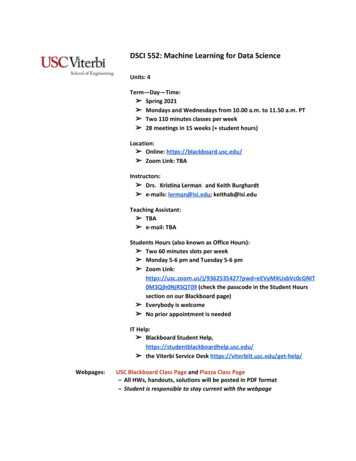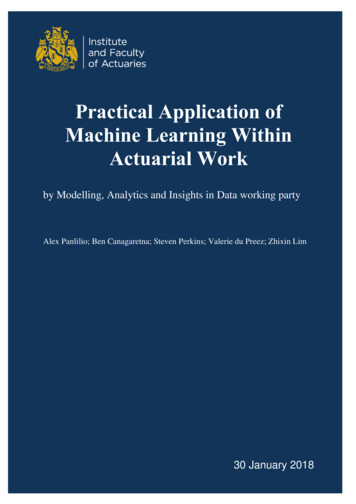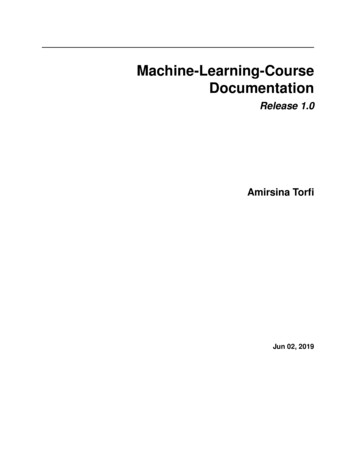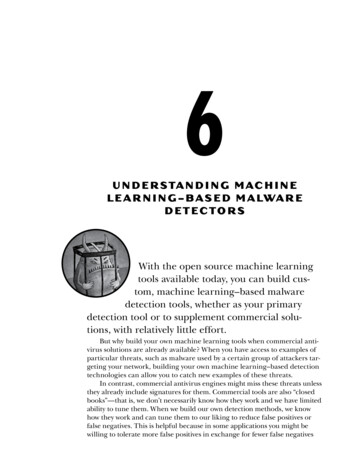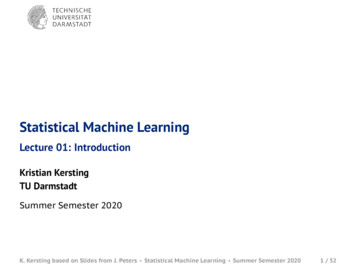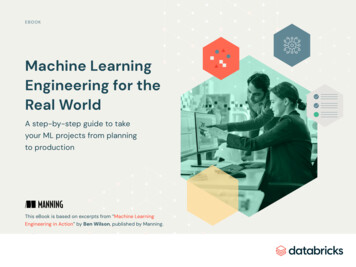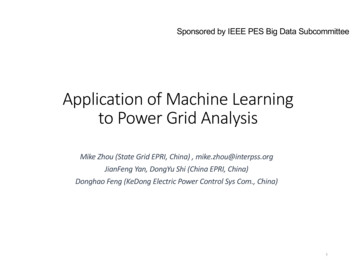
Transcription
Sponsored by IEEE PES Big Data SubcommitteeApplication of Machine Learningto Power Grid AnalysisMike Zhou (State Grid EPRI, China) , mike.zhou@interpss.orgJianFeng Yan, DongYu Shi (China EPRI, China)Donghao Feng (KeDong Electric Power Control Sys Com., China)1
AgendaF IntroductionOpen Platform for Applying Machine Learning (ML) Power Grid Model Service Research on Applying ML to Online DSA ML Research Roadmap of CEPRI2
Why ML Research Again?1996 AlphaGo Showcase – “impossible for at least 10 more years” "Artificial Intelligence is the New Electricity“ – Andrew Ng Open-source ML tools (Google TensorFlow [1])[1 ] “T e n s o rF lo w : A n o p e n -s o u rce so ftw a re lib ra ry fo r M a ch in e In te llig e n c e ”, h ttp s://w w w .te n s o rflo w .o rg /3
Basic Idea[y] [W][x] [b][x][y]NeuralNetworkLayer(1) Layer(n)4
ML Application Areas Image Recognition Self Driving Car Automation Robotics Predictive Analytics Power grid analysis has been guiding the operationsuccessfully Power grid analysis so far is model-driven Data-driven ML approach will be supplemental5
AgendaF IntroductionOpen Platform for Applying Machine LearningPower Grid Model ServiceResearch on Applying ML to Online DSAML Research Roadmap of CEPRI6
NN Model Training Data ML Main Steps: 1) Training; 2) Prediction Training data is the foundation for ML Training data set collection Large user data set collected by Google, Facebook Training data set generation Power grid operation depends on the simulation Guide the grid operation with proven record Contingency analysis could be done only through simulation Need grid analysis training data generation tools/platforms Open Platform for Application of ML to Power GridAnalysis has been created7
Platform ArchitectureGoogle ML Engine(TensorFlow)1.Training2.PredictionPS Model Service(InterPSS)Training CaseGenerator(Pluggable)8
Sample Study CaseNN-Model PredictionGen AreaInterfaceIEEE-14 Bus case as the basecase.Power is flowing from the Gen Area tothe Load Area. W hen the operationcondition changes, Bus voltage, P, Q prediction Interface flow prediction N-1 CA max branch power flowTraining CaseLoad Area Load bus P,Q adjusted by arandom factor [0 200%], loadQ is further adjusted byrandom factor [ /-20%] The load changes arerandomly distributed to thegenerator buses9
Bus Voltage Prediction(AC Loadflow) AC Power Flow Given bus PQ, compute bus voltage (mag, ang), such that max bus powermismatch (dPmax, dQmax) 0.0001 pu 1000 training date sets are generated and used to train the NN-model Input: bus P, Q, P2 Output: bus voltage, Prediction Using NN-Model 100 testing cases are generated using the same process as the trainingdata set, using the random load adjustment factors. The trained NN-Model is used to predict the bus voltagedV(mag)dV(ang)dPmaxdQmaxMaximum0.00118 pu0.00229 rad0.00937 pu0.00619 puAverage0.00028 pu0.00055 rad0.00225 pu0.00171 pudV(msg,ang): Bus voltage predicted is compared with the accurate AC Power Flow resultsdP/Qmax: Bus voltage predicted is used to compute the network max bus power mismatch10
Bus/Interface PQ Prediction(AC Loadflow) Bus P, Q Swing Bus P, Q prediction (100 testing cases) Average difference : Max difference:0.00349 pu0.01476 pu0.35 MW/Var1.48 MW/Var PV Bus Q prediction (100 testing cases) Average difference : Max difference:0.00353 pu0.02067 pu0.35 MVar2.07 Mvar Interface Flow Interface branch set [5- 6, 4- 7, 4- 9] Interface Flow P,Q prediction (100 testing cases) Average difference : Max difference:0.00084 pu0.00318 pu0.08 MV/Var0.32 MV/Var11
Max Branch Power Flow Prediction(N-1 CA) N-1 Contingency Analysis (CA) In N-1 CA, the branch power flow is calculated when there is a branchoutage. Furthermore, the max branch flow of each branch considering allcontingencies to check limit violation or for screening . 1000 training date sets are generated and used to train the NN-model Input: bus P, Q, P2 Output: max branch power flow Prediction Using NN-Model 100 testing cases are generated using the same process as the trainingdata set. Max branch power flow prediction is compared with the accuratesimulation results Average difference : Max difference:0.0134 pu0.0509 pu1.34 MW5.09 MW12
Open Platform forApplication of ML to Power Grid Analysis(Summary) Integration of Google TensorFlow and InterPSS[2] TensorFlow as ML engine InterPSS Provides power grid simulation model service Pluggable training data generator The Platform has been open-sourced Apache-2.0 License Open-source Project Location ning[2] “The InterPSS Community Site”, www.interpss.org13
AgendaF IntroductionOpen Platform for Applying Machine LearningPower Grid Model ServiceResearch on Applying ML to Online DSAML Research Roadmap of CEPRI14
Power Grid Model Service The Need For Creating the Training Data Power grid measurement data is not enough Training data for security analysis need to be created N-1 CA, transient/voltage stability limit Valid NN Model Prediction Accuracy Common ML Approach Collected Data set Training set Testing set Model service creates data on-demand randomly oraccording certain rules Based on InterPSS Simulation Engine Accurate power grid simulation model behind15
About InterPSSSolving power system simulation problem usingmodern software approach [3] InterPSS: Internet Technology-based Power SystemSimulator InterPSS project started in 2005 Object-oriented, Java programming language PSS/E, BPA , PSASP(China EPRI) similar functions Free software[3 ] M . Z h o u , “S o lv in g P o w e r S y ste m A n a lysis P ro b le m s U sin g M o d e rn S o ftw a re A p p ro a ch ,“ U S G o v F E R CIn c re a sin g M a rk e t a n d P la n n in g E fficie n cy th ro u g h Im p ro ve d S o ftw a re M e e tin g , D C Ju n e 2 0 1 0 .16
InterPSS Software ArchitectureExtensionsApplicationSuiteDesktop EditionInterPSS Core EngineCloud Editionü Integration withother systemsTraditional ApproachInterPSS ApproachLittle could be extendedand customizedApplication created byextension, integration andcustomization17
Power Network Object ModelInputA[ ]B[ ]C[ ]X[ ]Algo[4,5]AlgoInputY[ ]Z[ ]ObjectModelOutputProcess I/OOutputIn-Memory Data ExchangeAlgorithm-Focused PatternModel-Focused Pattern Data Processing Patterns Algorithm-focused Procedure programming approach PSS/E, BPA, PSASP (China EPRI) based on this pattern Model-focused Object-oriented approach InterPSS uses the Model-Focused Pattern[4 ] E . Z h o u , "O b je ct-o rie n te d P ro g ra m m in g C a n d P o w e r S yste m S im u la tio n ," IE E E T ra n s. o n P o w e r S ys te m s , V o l. 1 1 , N o . 1 F e b . 1 9 9 6 .[5 ] M . Z h o u , Q .H . H u a n g , “In te rP S S : A N e w G e n e ra tio n P o w e r S yste m S im u la tio n E n g in e ," su b m itte d to P S C C 2 0 1 818
Training Case GenerationSimulationServiceTrainingAlgo CaseGeneratorProcess I/OGoogle ML Engine(TensorFlow)In-Memory Data ExchangeInterPSSObject ModelPythonJavaPy4J Object and Algorithm Decoupled Relationship Common Algorithm Implemented Topology Analysis, Loadflow, N-1 CA, State Estimation Short Circuit Analysis, Transient Stability Simulation Training Data Generator Training data generation implemented as a special algorithm Use Py4J asthe runtime to host the object model and interface[6 ]with TensorFlow (Python)[6 ] “P y 4 J - A B rid g e b e tw e e n P yth o n a n d Ja v a ”, h ttp s://w w w .p y4 j.o rg /19
Power Grid Model Service(Summary) Based on InterPSS Simulation Engine Provide Flexible Power Grid Model Service InterPSS power network model hosted in a Java runtime environment Pluggable training data generator Create custom training data generator using InterPSS power network object model API20
AgendaF IntroductionOpen Platform for Applying Machine LearningPower Grid Model ServiceResearch on Applying ML to Online DSAML Research Roadmap of CEPRI21
DSA Challenges[7] Current DSA Repackage of off-line simulation programs (TS, Small-signal) Running in the batch mode periodically (15 min) In China State Grid dispatching center, a round trip takes 6-10 min tocomplete The online analysis model size is large-scale (40K buses) Challenges The time-domain simulation has limited speed-up room The simulation results are not intuitive for the operators Remedy actions cannot be directly derived from the results[7 ] M . Z h o u , e t a l, “D e v e lo p m e n t o f F a st R e a l-tim e O n lin e D yn a m ic S e cu rity A sse ssm e n t S ys te m ,” IE E ES m a rtG rid N e w s L e tte r, J u n e 2 0 1 6 .22
CCT Prediction Critical Clearing Time (CCT) Maximum time during which a disturbance can be applied withoutthe system losing its stability. Determine the characteristics of protections Measure quantitatively system dynamic security margin CCT Computation 100 sec using the simulation approach (40K Bus) ML-based approach: using Neural Network(NN) model to predict CCT23
NN-Model Based CCT PredictionCCTPredictionResultFirst LayerFeatureLast LayerFeature NN-Model (per contingency) is constructed (trained) for the CCTprediction; NN-Model input (First Layer Features) : power grid measurement info,such as Gen(P, V); Substation (P,Q), and z(i,j) between substations; A set of Last Layer Features are derived and used for CCT Prediction.24
Preliminary ResultsCCTLast LayerFeatureNetwork Size40K Buses,3370 SubstationsNN-ModelOutput500kVFirst t LayerFeaturesFeatureReduction500kVAutoEncoderCCT for a FaultZGen (P V) Substation(P, Q)between substations (Dimension :8772)i,jAbout 20Basic NN unit: AutoEncoder.220kV220kVFirst Layer aseTestingcaseTimeNN-ModelTimeSimulationAccRatioA Fault2.65%28.69%2459446602ms 100s251:50000
Basic NN unit: AutoEncoder“The aim of an AutoEncoder is to learn arepresentation (encoding) for a set of data, typicallyfor the purpose of dimensionality reduction.” About 30 min training time (one GPU, 40K-bus network) NN Model Input (First Layer Features) Gen P, V; Substation P, Q; Z between substations ( total 8K variables)i,j The goal is let AI to select through training a set of last layer features(artificial) for predicting CCT The Current Practice A set of key features (physical, such as interface flow) are selected byhuman expert to monitor the stability Use physical features or artificial last layer features to determine thesecurity margin?26
Potential Benefit Speed-up DSA System Response Speed For CCT prediction: 50K times faster (40K-Bus, 2ms vs 100s) Produce More Intuitive Results NN model to digest large-scale simulation outcome to create more intuitiveresults The “lookup” approach is very close to human operator experience Enhanced Decision Support NN model turns/reduces First Layer Features (P, Q, V) to Last Layer Features Use the Last Layer Features to compare the current case with historicsimulation cases to identify “similar cases” If remedy actions are needed for the current case, they could be found in thesimilar historic simulation cases.27
AgendaF IntroductionOpen Platform for Applying Machine LearningPower Grid Model ServiceResearch on Applying ML to Online DSAML Research Roadmap of CEPRI28
CEPRI Power System Simulation GroupML Research Roadmap(1) New super simulation center (China State Grid) Massive processing power (750 Blades, 20K cores) Massive storage room (2.4 PB, 2M cases) Production support for State Grid dispatching centers in China Training data set Collect real-world simulation cases and results Based on the human experience to generate more scenarios based onthe recorded history operation cases Use to train NN-models for the predictive analysis29
CEPRI Power System Simulation GroupML Research Roadmap(2) Simulation result processing The new simulation center will generate massive simulation result The human experts are not capable to process the result Digest massive simulation results using NN-model Discover knowledge to guide China’s UHV power grid operation30
Summary AI, especially ML, landscape has been fundamentallychanged over the last 5 10 years The development speed is unprecedented Many breaking-through successful stories The enabling technologies are accessible to everyone Powerful computing hardware (CPU GPU) New open source software tools The right time to renew/restart research onapplication of ML to power grid Open collaboration approach is recommended31
Thank YouQ&A32
Application of Machine Learning to Power Grid Analysis Mike Zhou (State Grid EPRI, China) , mike.zhou@interpss.org JianFeng Yan, DongYu Shi (China EPRI, China) Donghao Feng (KeDong Electric Power Control Sys Com., China) 1 Sponsored by IEEE PES Big Data Subcommittee



